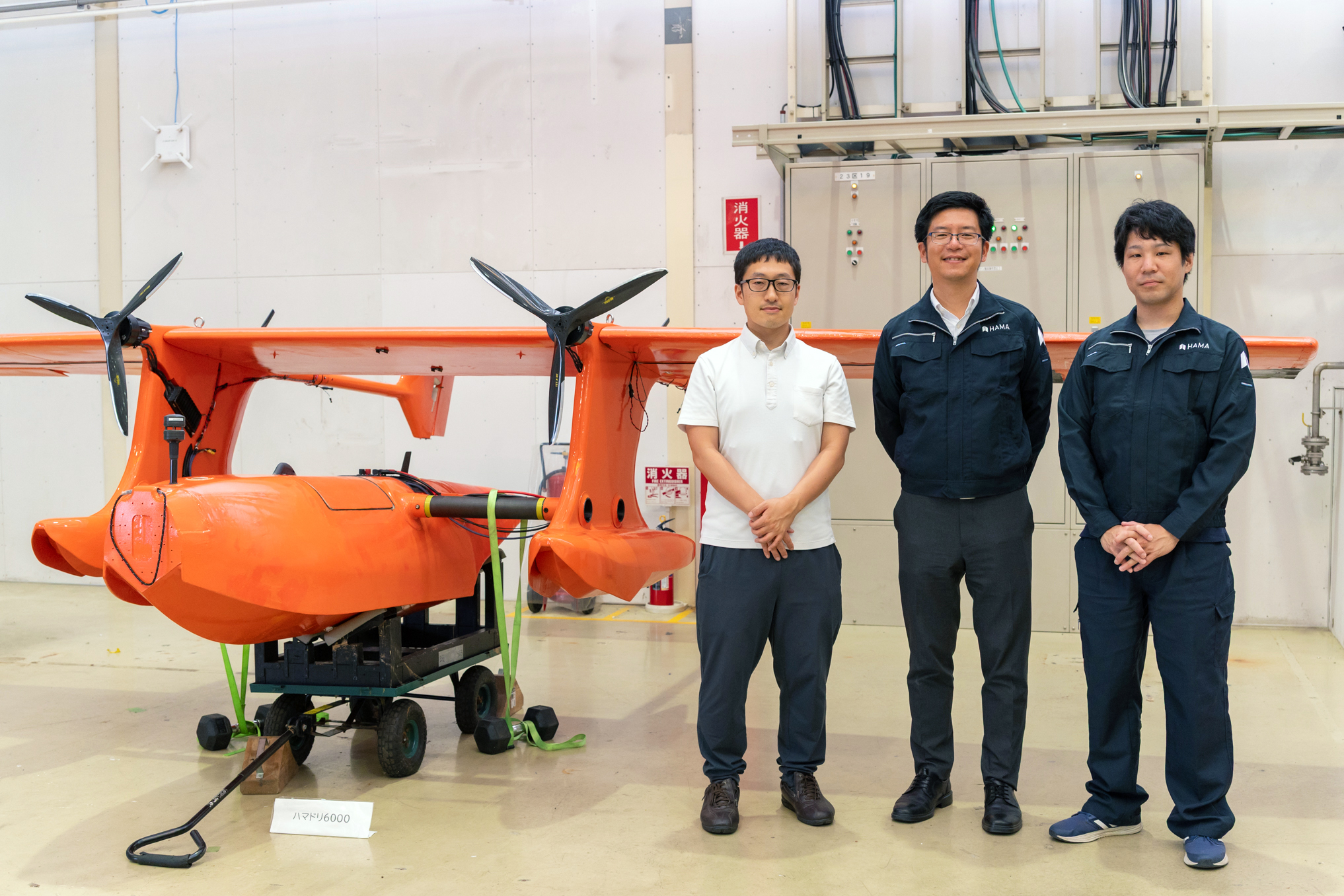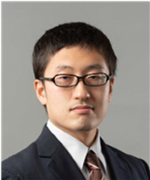Behind the Scenes of the World’s First UAV Seabed Observations
Yusuke Yokota (UTokyo-IIS) × Masata Kaneda and Kento Suzuki (HAMA, Inc.)

Associate Professor Yusuke Yokota of the Institute of Industrial Science, The University of Tokyo, achieved a world first this year by successfully measuring the position of the seabed with centimeter-level precision using an unmanned aerial vehicle (UAV) developed in collaboration with HAMA, Inc., which also served as a joint research partner. The following discussion gives some insight into how Kaneda and Suzuki at HAMA, together with Yokota, succeeded at these observations, and also reveals the significance and appeal of industry-academia collaboration.
Photo: From left to right Yokota, Kaneda, Suzuki
Related Article> UAV-Based Deep-Sea Observation Technology Brings Us Closer to Unraveling the Mechanisms of Massive Earthquakes (Associate Professor Yusuke Yokota)
The world’s only flying boat-type UAV capable of offshore seabed monitoring
――This groundbreaking achievement came to fruition when Yokota’s observation plan was carried out using the UAV developed by HAMA. This breakthrough is now attracting attention as a significant step toward unraveling the mechanisms of large-scale earthquakes. To begin with, could you tell us how this joint research project got started?
Yokota: Seabed measurements are currently conducted using ships. However, because these require considerable expenditures of time and money, it is difficult to take frequent measurements. At the beginning, I consulted with Dr. Katsuyoshi Kawaguchi at the Japan Agency for Marine-Earth Science and Technology (JAMSTEC), who was serving as a visiting professor at UTokyo-IIS. Following our discussions, I began developing a method for conducting seabed observation using UAVs. At the time, however, I was unable to find a UAV that could both fly far out to sea and take off and land on the sea surface. That was when I came across a newspaper article reporting that HAMA was developing a flying boat-type UAV with fixed wings and a flight range of over 100 kilometers. I thought, “This is it!” and immediately reached out—that was how it all began.
Kaneda: I clearly remember that our first meeting took place on March 11, 2020. Our company is now located in Fukushima. We decided to relocate to that area after participating in the Fukushima Innovation Coast Framework, a project launched after the Great East Japan Earthquake to attract growth industries to the region. On March 11, nine years after the earthquake, a researcher studying earthquakes visited our company to seek our collaboration. I felt a sense of destiny.
Yokota: At the time, HAMA’s aircraft was too small to carry the observation equipment, so it was necessary to develop a larger model. Even so, we were truly grateful that they readily agreed to take on the challenge.
Kaneda: Yokota explained that there would be strong demand if we could develop a UAV capable of marine observation and surveying, and that really encouraged us. Or maybe it was that his explanation just made it sound too tempting (laughs). At any rate, we are indeed receiving a variety of inquiries—just as he predicted.
Yokota: Helicopter-type drones have short flight ranges, which make offshore ocean observations difficult. Even now, I believe that only HAMA’s aircraft is capable of carrying out the kinds of observations I had envisioned.

Repeated experiments at sea led to the creation of the aircraft required
――What kinds of challenges or difficulties did HAMA face in developing this new, larger aircraft?
Suzuki: Making the aircraft larger entailed challenges we had never faced before, so we had to devise a variety of creative solutions. One of the most difficult tasks was installing the acoustic transducer used for seabed observations. At first, we mounted the equipment on the underside of the aircraft. However, we found that with the larger model, this had a more significant impact on landing, causing the transducer mounts to break and water to leak in.

A hole was drilled in the bottom of the aircraft to mount the equipment.
――And how did you resolve that?
Suzuki: We reinforced the transducer mounts by attaching polycarbonate plates around them to cushion the impact from the water surface. This approach allowed us to complete the recent observations, but it reduces takeoff performance, so we are now considering redesigning the airframe shape for the future. We plan to divide the central fuselage into two sections arranged side-by-side, and turn the hollowed-out center into a space for mounting equipment and other items.
Yokota: I imagine it must have been very difficult to figure out how to install multiple devices while still maintaining adequate flight performance. We had to repeat the cycle countless times—conducting experiments, holding discussions, making repairs and adjustments, and then experimenting again.
――Where did you carry out the experiments?
Kaneda: We conducted experiments both in water tanks and out at sea, but mostly out at sea. For these, we used the waters offshore from the Fukushima Robot Test Field, which was established as part of the project mentioned earlier. Our company was located right next to the ocean, which thankfully made it very easy to conduct experiments out at sea.
Yokota: It’s difficult to artificially reproduce ocean waves and swells, which is why conducting experiments in the actual sea is so important, right?
Kaneda: That’s right. Repairing the damaged aircraft after each experiment was a challenge, but the repeated experiments out at sea helped us identify problems early and bring the project to completion in a relatively short time—about two years. Incidentally, the seabed observation experiment that Yokota also participated in was conducted in Sagami Bay, which contains the Sagami Trough with depths exceeding 1,000 meters. For that experiment, we transported the equipment and the aircraft by truck from Fukushima to the site. Night after night during the experiment, whenever the aircraft had encountered problems, we would have to repair it inside the truck.
Yokota: Everyone’s hard work is very much appreciated.

We couldn’t feel at ease until we confirmed the signal from the seabed
――The joy you felt at the moment the experiment succeeded must have been tremendous.
Kaneda: Ordinarily, when developing aircraft, it’s usually, “Oh, it flew! We did it!” But in this case, we couldn’t call it a success until we actually detected signals from the seabed. So, there wasn’t really a moment when we could immediately celebrate.
Yokota: In observational experiments, the observation equipment may encounter issues even if the aircraft itself has no problems. So indeed, it’s often difficult to know right away whether the experiment was a complete success.
Suzuki: For me, working on a computer back on land, I felt relieved the moment I entered a command to communicate with the seafloor and saw data coming back—“We’re getting data!”
Yokota: All of the HAMA employees remained vigilant until they could confirm that the data had been obtained. For me as well, once I saw the signal from the seafloor, I was relieved and thought, “Alright, the rest should all go well.”
A joint research project that united us in the desire to create something truly great
――In this project, HAMA, Inc. and Yokota carried out a joint research project in the form of collaboration between industry and academia, leveraging their unique perspectives as a company and a researcher. What impressions did you have of each other, given your different standpoints?
Kaneda: We are very grateful that Yokota is so mindful of the corporate perspective. It makes us feel that our joint research efforts are progressing smoothly.
Yokota: Although it’s not a company, I used to work for the Japan Coast Guard. Through that, I was able to see various aspects of organizational logic, and perhaps that experience has been of some help during this project. On the other hand, I imagine Kaneda and his team have also had many opportunities to work with universities, so I feel our perspectives weren’t really all that different to begin with.
Kaneda: That’s true. Many of us have a strong passion for research, so when we come across an exciting theme like in Yokota’s research, we throw ourselves into it wholeheartedly—setting business considerations aside and pursuing our desire to create something truly great. Academics are able to engage in purely exploratory research head-on—the kind that would be difficult to pursue within a business-driven private company. Being involved in that sort of thing is a tremendous source of inspiration for us as well, and truly enjoyable.
Yokota: In most cases of joint research with companies, it’s usually just the technical staff who come to conduct the experiments. But in HAMA’s case, a full team of about ten people––including the president and even members of the sales staff––showed up. That left the strongest impression on me. When a challenge arose, everyone would unite and enjoy overcoming it as a team, and that atmosphere was truly wonderful. In any case, I’m grateful that we can continue to engage in research together with such a positive relationship.
Aiming to develop technology for use in observations by specialized institutions
――Finally, could you tell us about your outlook for the future and your aspirations?
Yokota:Although we have succeeded in conducting seafloor observations, the research itself is still only in its initial stages. At present, we are only at the stage of experimental observations in the laboratory. Going forward, we want to continue researching operational methods and cost efficiency, with the goal of refining this technology so that it can eventually be used for regular observations by specialized institutions.
Kaneda: Looking ahead, we need to package everything from flight performance to observation capabilities into a form that can be offered back to society. At the same time, to ensure sustainability, we also need to make it a viable business. There is still much to be done.
Suzuki: With those goals in mind, I intend to keep driving forward with improvements to the aircraft, including changing its shape as mentioned earlier.
Yokota: As for HAMA, since you’ve already developed numerous connections with marine-related companies, I expect things will only get busier for you from here. Still, I hope you will continue to support this research!
――We are all interested in seeing how things develop from here.

The discussion was warm and friendly, with the three occasionally bantering like a comedy troupe.
Related Link> HAMA Inc.

Featured Researcher
Yusuke Yokota
(Associate Professor, Institute of Industrial Science, The University of Tokyo)
Special Field of Study: Underwater Information System
Since its establishment in 1949, the Institute of Industrial Science, The University of Tokyo has advanced engineering research from basic to applied, with a strong focus on collaboration with industry. Through numerous joint and commissioned projects, UTokyo-IIS has become a front-runner in industry–academia collaboration, fostering partnerships with corporate researchers and engineers and delivering its research outcomes to society.



Comments
No comments yet.
Join by voting
How did you feel about the "Possible Future" depicted in this article? Vote on your expectations!
Please visit the laboratory website if you would like to learn more about this article.
Share